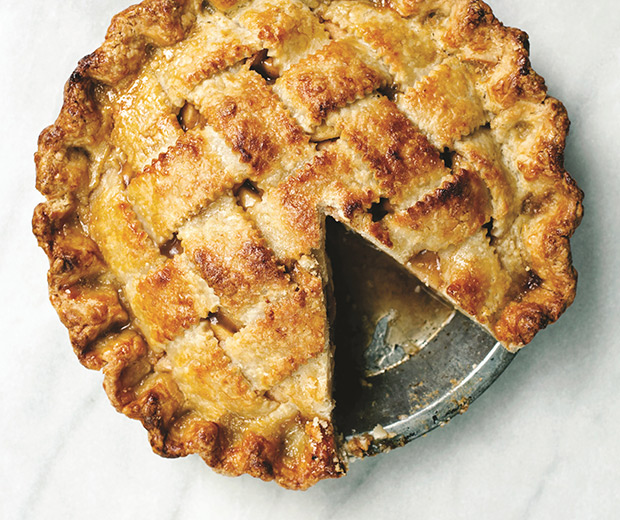Recipe
November 7, 2016
Tara O’Brady’s Caramel Apple Pie

Try this recipe from the Seven Spoons: My Favorite Recipes for Any and Every Day cookbook by Tara O’Brady. Plus, check out Tara’s recipes for Roasted Carrots, Vietnamese-Inspired Sausage Rolls and Roasted Squash Soup.
“It’s hard to resist the urge to get stuck in a pie while it is fresh and hot from the oven, but if you can resist, do. The juices require time to thicken to their sumptuous best, which allows for neater slices when dishing out. For the apples, a mix of tart and sweet baking varieties like Pippin and Golden Delicious, Braeburn or McIntosh are nice. And, by macerating the fruit at room temperature, as is done with jam, then reducing that collected liquid, the filling has that much of a lead toward later lusciousness.”
Directions
Yield: Makes a 9-inch (23 cm) pie
- Lightly butter a 9-inch (23 cm) pie pan and set aside. Squeeze the lemon juice into a large, nonreactive bowl. Peel, core, and cut the apples into ¼-inch (6 mm) slices, adding them to the bowl as soon as they are cut. Turn the apples in the lemon juice now and again while you work. Toss the apples with the sugars and salt. Cover and leave at room temperature for at least 1 hour and up to 4 hours, or refrigerate overnight. Stir whenever you remember to do so. If you haven’t already, this is a good time to make the pastry. (Instructions below.)
- Set a colander over a large heavy pot. Turn the apples into the colander and let them drain completely. Flip the apples back into their bowl and pour the juice into a liquid measuring cup, taking note of the amount. Melt the butter in the pot over medium heat. Let it brown, swirling occasionally. Add the drained apple liquid and bring to a boil without stirring. Reduce the liquid to ½ cup (120 ml).
- Toss the apples with the cornstarch, cinnamon, and nutmeg, until the cornstarch dissolves. Pour the reduced juices over the top and fold to combine. Set aside.
- On a lightly floured work surface, roll half the dough out to a 12-inch (30.5 cm) round. Drape the dough over the prepared pan and gently ease into place, snug against the bottom and overhanging at the rim. Fill tightly with the apples and the juice, mounding the fruit toward the center. Place in the fridge. Roll out the remaining dough to a 12-inch (30.5 cm) round and either cut into strips for lattice or leave as is. Retrieve the pastry shell from the fridge. Brush the edge of the lower crust with beaten egg, reserving any remaining egg. Place the top crust over the filling, or weave the lattice directly on top of the filling. Press the top and bottom crusts together to seal, then crimp or decorate. Pop the whole pie in the freezer for 15 minutes.
- While the pie chills, preheat an oven to 375°F (190°C) with a rack in the lower third of the oven. Line a rimmed baking sheet with parchment paper.
- Brush the chilled pastry with the remaining egg wash. Sprinkle with sugar. For solid-top crusts, cut steam vents with either a knife or a small cookie cutter. Set the pie on the prepared baking sheet and bake until the juices are bubbling and the apples succumb to the tip of a knife, 50 minutes or so. If the crust browns too quickly, protect it with a layer of foil.
- Remove the pie from the oven and cool on a wire rack for at least 1½ hours. Serve with vanilla ice cream.
Family-Approved Pie Dough Recipe
“My mother taught me to put an egg yolk in pie dough, adding richness and a hint of elastic strength, and making the pastry a dream to work with. (I keep the white around for an egg wash before baking whatever pie I’ve made.) Pie crust recipes will often have similar ingredients and proportions. The fact is, there’s a pretty set ratio of our to fat because the our will only be able to take a certain amount of fat before it starts to weep all over the oven. Something to keep in mind: Laminated dough swells forcefully when baked. Consider rubbing the butter into smaller pieces when forming the dough, and ignore the rolling and folding step when making a pie with a raised, intricate edge—in which case, divide the dough in two before the first rest. There will be less puff, but the decorations will stay neat.”
- In a large, wide bowl, whisk the flour with the sugar and salt. Scatter the butter over the flour. With the pads of your fingers, squish each cube of butter into thin cakes, in a motion similar to dealing cards off the top of a deck. Toss the butter into the dry ingredients as it is flattened, so that it is kept coated on all sides. Once all the butter has been squashed, chill the mixture for 30 minutes.
- Stir the egg yolk with the vinegar in a 1-cup (240 ml) liquid measure, then add enough ice water to make ¼ cup (60 ml) total. Drizzle the liquids over the flour and butter mixture, then, with a butter knife, start stirring the wet into the dry. After a few stirs, abandon the knife and use your hands or a spatula to pick up stray flour and press it into the damp pockets of dough. Continue collecting the dough together in this way, pushing and smearing the mass against the bowl. This will not only incorporate the flour but also create long sheets of fat within the dough in a lazy-person’s version of fraisage, a classic pastry technique. If the dough seems dry, stingily drip in more ice water as needed. Once the lion’s share of the our is incorporated, fold the dough onto itself a few times, trapping any remaining our in the folds. Cautiously pat out the dough in between each fold, and shift the bowl a quarter turn so that the dough isn’t always folded the same way. The dough should be together, albeit raggedly, with visible pieces of butter.
- Tip the dough onto a work surface and shape into a round. Wrap with plastic wrap. Once sealed, press firmly, so that the film is good and tight and the dough looks like it could burst from its wrapping. I feel this binding helps the dough in the end, encouraging the dry ingredients to fully absorb the wet. Refrigerate for 30 minutes.
- Lightly flour a work surface, a rolling pin, and both sides of the unwrapped dough. Roll the dough into a long rectangle. Dust off the excess flour and fold into thirds, like a business letter. Turn the package 90 degrees and roll out again, flouring the board, rolling pin, and dough as needed. Brush away loose flour, then fold as before. If ever the dough gets too warm, cover and chill before proceeding. Turn the package a final time and roll the dough into a rectangle double the length of its width and cut in two. Shape the pieces into rounds, wrap snugly with plastic wrap, and chill for at least 1 hour, and up to 2 days, or freeze for up to 1 month. For frozen dough, defrost in the fridge before using.
Whole Wheat Variation: Up to about ¾ cup (85 g) whole wheat flour can be swapped in for the same amount of white, though the crust will not be as flaky. Use whole wheat pastry flour if you can.
Sour Cream Variation: For an especially delicate crust, use 2 tablespoons sour cream or whole-milk yogurt instead of the egg and vinegar.
Eggless Variation: Omit the egg (keeping the vinegar) and make up the extra liquid with more ice water.
Lard Variation: Substitute lard for the same amount of butter; lard will make for a ner, more fragile crust. A mix of butter and lard— say, ¾ cup (170 g) butter to ¼ cup (60 g) lard—will give the best of both worlds.
Sweet Variation: Use up 2 tablespoons sugar for a shell destined for a sour or mild filling (such as lemon curd or labneh).
Cheese Variation: A few tablespoons of a grated hard cheese, such as Parmesan, Pecorino, or aged cheddar, gives extra personality to quiche or vegetable tarts. Grind in some black pepper, too.
Excerpted from Seven Spoons: My Favorite Recipes for Any and Every Day by Tara O’Brady. Copyright © 2015 Tara O’Brady. Published by Appetite by Random House®, a division of Penguin Random House Canada Limited. Reproduced by arrangement with the Publisher. All rights reserved.


